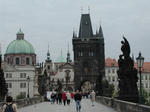
It is Prague's most familiar monument.Il Ponta Carlo fu costruito da Carlo IV. -re Ceco ed imperatore Romano nel 1357 e per quattro secoli serví come unico mezzo di collegamento tra le due parti di Praga. It is an impressive piece of medieval engineering, aligned between two Gothic gateways.
Since its construction a wooden crucifix has stood on the bridge, swept off during the Hussite wars, than replaced by a bronze one. But the first sculpture wasn't added until 1683, when St. John of Nepomuk appeared. His statue was such a success that another 21 were added between 1698 and 1713, including
work by Brokoff and Braun. Today 30 statues decorate the bridge. Despite just a few works being outstanding, set against Prague Castle, the effect is breathtaking.
The 520 m - 1770 ft long, 10 m - 35 ft wide, 16 arches bridge connecting the 'Lower Town' with the 'Old Town', has served as a marketplace, a battlefield and an execution site. Today it is full of tourists, souvenir stalls and performers.
Legend has it Count
Bruncvik had his magic sword buried in one of the pillars after his death. The sword is said to appear when the Czech nation is threatened.
The bridge draws people because of its location, stunning views, statuary, and the array of activities that occur there, all concentrated
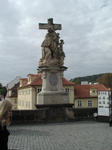
along the bridge's narrow, 30' width. The span is a crucial link from the left to the right bank of the Vlatava, and offers breathtaking views of Kampa Island, Prague Castle, and the river itself. Sculpted over a period of 250 years beginning in 1683, its statues are a major draw for tourists and art lovers, particularly the beautiful Baroque-period works. In addition to accommodating pedestrians, the bridge provides a forum for a great variety of vendors (of woodwork, jewelry, and paintings), street musicians, puppeteers, and even trained dogs.
Kampa
Island under the Charles Bridge giving a view at the Vltava River and the National Theatre, at one time it was the place of renowned poteers' markets.
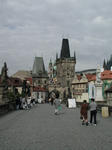
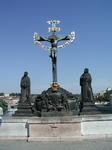
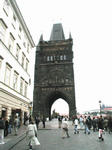
 Guide
Guide 





